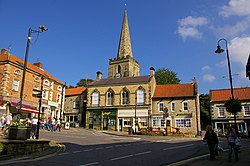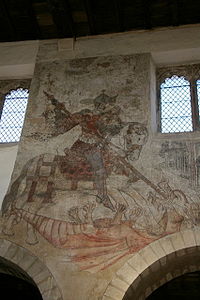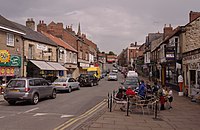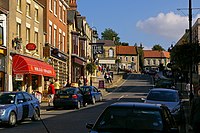Pickering
| Pickering | |
| Yorkshire North Riding | |
|---|---|
 Pickering | |
| Location | |
| Grid reference: | SE797838 |
| Location: | 54°14’38"N, 0°46’34"W |
| Data | |
| Population: | 6,846 |
| Post town: | Pickering |
| Postcode: | YO18 |
| Dialling code: | 01751 |
| Local Government | |
| Council: | Ryedale |
| Parliamentary constituency: |
Thirsk and Malton |
Pickering is an ancient market town in the North Riding of Yorkshire at the foot of the North York Moors, overlooking the Vale of Pickering to the south.
According to local legend the town was founded by King Peredurus around 270BC; however, the town as it exists today is of mediæval origin. The legend states the town was named by King Peredurus; he lost his ring and accused a young maiden of stealing it, but later that day the ring was found in a pike caught that day in the Costa Beck for his dinner. The king was so happy to find his ring he married the young maiden. The name Pike-ring got changed over the years to Pickering.
Pickering Parish Church is known for its mediæval wall paintings. Also round about are Pickering Castle, the North Yorkshire Moors Railway and Beck Isle Museum, which have made Pickering popular with visitors.
Contents
Geography
Pickering is at the junction of the A170, which links Scarborough with Thirsk, and the A169 linking Malton and Whitby. It occupies a broad strip of land between the Ings and Low Carrs to the south of the main road and a ridge of higher, sloping ground which is surmounted by the castle to the north. It is sited where the older limestone and sandstone rocks of the North York Moors meet the glacial deposits of the Vale of Pickering. The limestone rocks form the hill on which the higher parts of the town and the castle stands.
Pickering Beck runs north to south through the centre of the town, the town centre on the east bank. It rises on the moors and drains southwards through Newton Dale before reaching Pickering. The beck is prone to flooding at times of exceptional rainfall.
Pickering has developed around the old Market Place but the majority of houses are now in the residential estates off the main A170 road.
To the north of Pickering is the high moorland of the North York Moors, rising from 160 feet above sea level at its southern edge to over 1,410 feet on Urra Moor. It is dissected by a series of south-flowing streams which include Pickering Beck. Most of the moorland consists of Jurassic sandstone with occasional cappings of gritstone on the highest hills.
To the south these rocks are overlaid with oolitic limestone which forms flat-topped tabular hills with an escarpment to the north and gentler slopes to the south. Ice action in the last glaciation deepened pre-existing valleys, and determined the line of the rivers and streams. Newtondale to the north of Pickering was cut by meltwater from ice in Eskdale gouging a deep channel as it flowed southwards to the lake which filled the Vale of Pickering. South of Pickering, extensive marshes have been drained and exploited as fertile agricultural land.
History
Positioned on the shores of a glacial lake at the end of the last Ice Age, Pickering was in an ideal place for early settlers to benefit from the multiple natural resources of the moorlands to the north, the wetlands to the south, running water in the beck and the forests all around. It had wood, stone, wildfowl, game, fish, fresh water and fertile easily worked soils. The east–west route from the coast passed along the foothills of the North York Moors through the site at a place where the beck could be forded.[1]
There is evidence of Iron Age and Roman era habitation in the areas surrounding Pickering but little remains in the town. Legendary sources suggest an early date for the establishment of a town but traces of earlier settlements have been erased by subsequent development.
According to the Domesday Book there was enough arable land for 27 ploughs, meadows and extensive woodlands. The town may have grown up to service the Norman castle.[2]
After the conquest
After 1066 when William of Normandy became the king the town and its neighbourhood was in the possession of the crown. A castle and church were built at this time and the mediæval kings occasionally visited the area. In 1267 the manor, castle and forest of Pickering were given by Henry III to his youngest son, Edmund,[3] First Earl of Lancaster. The estate was confiscated by the king and then returned. Eventually, it passed to Henry, Duke of Lancaster who became King Henry IV of England. It has belonged to the monarch ever since.
In 1598 the streets of Pickering were: East Gate, Hall Garth, Hungate, Birdgate, Borrowgate (the present Burgate) and West Gate.
Many older small houses were built at this time, some of stone with thatched roofs. The stocks, shambles and the market cross stood in the centre of town in the Market Place. The castle fell into disrepair yet the town flourished. In the Civil War, Parliamentary soldiers were quartered in the town and damaged the church and castle and Pickering was the location of a minor skirmish but not a pitched battle.
In the 1650s George Fox, the founder of Society of Friends, or Quakers, visited the town to preach on at least two occasions.
Modern period
Pickering prospered as a market town and agricultural centre. It had watermills and several inns and was a centre for mail coach traffic and trade. At this time the beck was an open sewer and it remained so until the early part of the 20th century.
Many townsfolk joined non-conformist denominations and the town was visited by John Wesley on several occasions, the first in 1764 and the last in 1790. The Quakers held meetings in a cottage long before they built their Meeting House in Castlegate in 1793. In 1789 the first Congregational Church was built in Hungate and for several years following 1793 a private residence was licensed for divine worship by Protestant dissenters.[4] The Pickering Methodist Circuit was formed in 1812. Non-conformism flourished in Pickering during the 19th century and meeting houses and chapels were enlarged. There were both Wesleyan and Anglican schools in the town from the middle of the century.
The Whitby and Pickering Railway was opened in May 1836. At first the carriages and wagons were horse drawn but steam locomotives were used from 1847.[5] The Forge Valley Line ran from 1882 to 1950, connecting Pickering to the Whitby–Scarborough line.[6] The local Health Board (the forerunner of the Urban District Council) was formed in 1863. A gas and water company provided gaslight and piped drinking water. The shop fronts were closed in and glass windows were used to display goods for sale.
20th century
In 1922 an old mill was converted to the Memorial Hall in memory of the Pickering men killed in the Great War. This hall, now modernised, serves as a community centre. The Castle Cinema was built in 1937 in Burgate. Electricity had arrived a few years earlier.
The years from 1920 to 1950 saw a decline in Pickering's role as an agricultural market town and the population fell from a peak of 4,193 in 1951 to 4,186 in 1961. The closure of the railway in 1965 under the Beeching axe was a blow to the area.
The economy of the town saw a turn around in the following decades with the greater mobility of the working population and a rise in tourism due to increasing car ownership. Tourism is a major occupation since the reopening of the North Yorkshire Moors Railway as a restored steam railway and the filming of the television series Heartbeat on the moors. In 1991 the population was 6,269.
Sights of the town
The parish church is at the eastern end of the Market Place and dominates views of Pickering from all directions. It is a Grade I Listed building that dates from the 12th century. It is notable for its mid-15th-century wall paintings, which cover the north and south walls. The wall paintings were covered over at the Reformation, but rediscovered in 1852. They were painted over once more, but were restored in the 1870s. The church is open every day.
North of the church at the top of the hill is Pickering Castle, which was built in the late 11th century to defend the area against rebellion and the Danes, and later the Scots. The sloping Market Place between the church and the beck is lined with two- and three-storey buildings dating from a variety of periods. Most are listed for their historical or architectural interest. This area is the centre of the town's main Conservation Area.
Flooding
Pickering Beck has a history of flooding, which occurs on average every five years. However, out-of-bank flows are experienced on some sections of the watercourse annually. These areas include Potter Hill and the grassed area upstream of Pickering Bridge. The flood in March 1999 caused widespread damage to the town.[7] Flooding in 2006 caused extensive damage to properties in the Market Place as well as the above areas.
Economy
Pickering has two main shopping areas, Market Place, which is by far the larger, and Eastgate Square, which is a mixed housing and retail development. There is a small supermarket off the Market Place.
There are few large employers in the town and a great deal of employment in te town is in retailing, tourism and small industries based in the two industrial development areas at Westgate Carr Road and Thornton Road to the west and east of the town respectively.
Pickering is an important tourist centre and there are banking, insurance and legal services in the town as well as an outdoor market each Monday. In 2008, plans were put forward to build a new supermarket in the area of an old coal yard.
Culture and sport
There are three theatre venues in the town offering a very wide range of amateur and professional productions. In July the annual Jazz Festival is held in Pickering.
There is a leisure centre, a swimming pool and a modern library and information centre. Sports activities include athletics (track and field), football (soccer), cricket, badminton and bowls. Pickering is home to Pickering Town F.C., who currently play in the Northern Counties East Football League Premier Division, Level 9 of the football league pyramid.
Media
- Newspapers:
- Ryedale Mercury (weekly)
- Scarborough Evening News (daily)
- Evening Press (daily)
- Gazette and Herald (weekly)
Parish church
Pickering Church has an Anglo-Saxon foundation, but the earliest phases of the present building date to the 12th and 13th centuries, with substantial additions in the 14th and 15th.
In 1853 restoration work revealed a series of wall paintings on the north and south walls of the nave. Despite a local and national outcry, the paintings were whitewashed, and only rediscovered and restored in 1876–78. They have been called “the most complete collection of mediæval wall paintings in England”.[8]
Places of interest in and around Pickering
The Beck Isle Museum is housed in a Regency period residence near the centre of town, adjacent to the Pickering Beck, a stream that flows under a four-arched road bridge. It was here that William Marshall[9] planned Britain's first Agricultural Institute in the early 19th century. The house contains a collection of bygones relating to the rural crafts and living style of Ryedale. The collection is not restricted to a particular period, but aims to reflect local life and customs and trace the developments in social and domestic life during the last 200 years. A selection of photographs from the Sidney Smith collection held in the museum are displayed around the building, particularly in the photography and model rooms. Sidney Smith was born in Pickering. He is thought of as a successor to Frank Meadow Sutcliffe of Whitby. The museum is owned by the Beck Isle Museum Trust and is staffed and operated by volunteers.
Dalby Forest is on the southern slopes of the North York Moors National Park. The southern part of the forest is divided by valleys creating a 'Rigg and Dale' landscape whilst to the north, the forest sits on the upland plateau. Although the forest is mostly pine and spruce, there are many broadleaf trees such as oak, beech, ash, alder and hazel in the valleys and on the 'Riggs'. Clear streams arising as springs run north and south out of the forest which is home to the crossbill and the nightjar. Roe deer abound and badgers, the symbol of the forest, are a common but nocturnal resident. The signs of the past are evidenced in burial mounds, linear earthworks of unknown purpose and the remains of a rabbit warrening industry can be found in the wood. A network of forest roads including the 9-mile Dalby Forest Drive provide access. The landscape was formed in the last Ice Age and shaped by the people of the Bronze Age to the present day.
North Yorkshire Moors Railway
- Main article: North Yorkshire Moors Railway
The North Yorkshire Moors Railway is a heritage railway. The 18-mile line is the second-longest heritage line in the United Kingdom and runs across the moors from Pickering via Levisham, Newton Dale and Goathland to Grosmont. It is run by the North York Moors Historical Railway Trust and operated and staffed by volunteers.
Pickering station has been its terminus since 1965 when the Malton-Pickering route connecting to the York to Scarborough main line was closed. Before the station became a terminus, the double-track railway took up the space now occupied by The Ropery (a road) and the car park to the east. Trains run daily from mid-March to early November and on selected dates through the winter. Trains are mostly steam-hauled; however in some cases heritage diesel engine is used. At the height of the running timetable, trains depart hourly from each station. During the summer months, steam services extend to the seaside town of Whitby. Passenger numbers have topped 300,000 in recent years.
Pickering Castle
- Main article: Pickering Castle
Pickering Castle is situated at the edge of the moors. It is a classic, well-preserved example of an early motte and bailey castle refortified in stone during the 13th and 14th centuries, centred upon a shell keep crowning an impressive motte. There is an exhibition in the chapel.
Events
Pickering is host to a very popular War Weekend, which consists of parades, soup kitchens, and much more fun! There is also a theatre named Kirk Theatre which is a popular tourist attraction.
Outside links
| ("Wikimedia Commons" has material about Pickering) |
- Pickering Town Council
- Pickering Parish Church Home to the Famous 15th century Wall Paintings
- Home, Gordon: The Evolution of an English Town, a history of Pickering since pre-historic times
- Pickering Town Guide (Needs Adobe Acrobat.)
References
- ↑ The Evolution of an English Town, a history of Pickering since pre-historic times. Gordon Home.
- ↑ http://www.castleuk.net/castle_lists_north/100/pickeringcastle.htm
- ↑ See the Yorkshire History website under 'Pickering'.
- ↑ Parishes – Pickering - A History of the County of York North Riding: Volume 2}}
- ↑ A History of the Whitby and Pickering Railway. Potter 1905
- ↑ "Pickering Tourist Information". Hello-Yorkshire.co.uk. http://www.hello-yorkshire.co.uk/pickering/tourist-information. Retrieved 4 June 2009.
- ↑ Pickering Flood Alleviation Scheme. Environment Agency UK
- ↑ Giles, K (2000) Marking Time? A fifteenth-century liturgical calendar in the wall paintings of Pickering parish church, North Yorkshire: Church Archaeology,4. pp. 42-51.
- ↑ "EH.Net Encyclopedia: William Marshall". eh.net. http://eh.net/encyclopedia/article/stead.marshall. Retrieved 26 May 2009.






